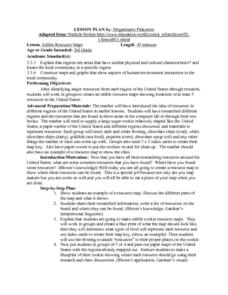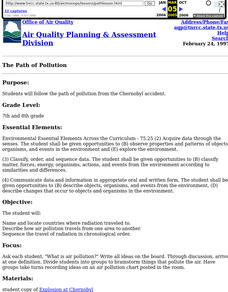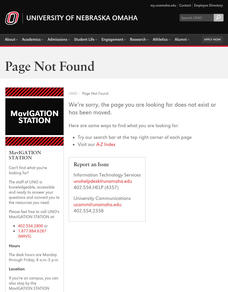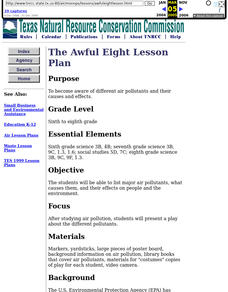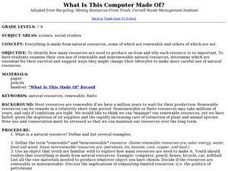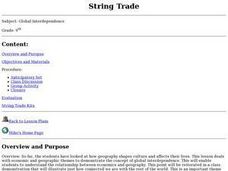Curated OER
Cycling Energy
Fourth graders are introduced to how electricity is produced. In groups, they compare and contrast the linear production of energy with other forms of mechanical energy production. They try to make a turbine work acting like it is part...
Curated OER
Mission 7: Saving Energy
In these saving energy worksheets, students learn about energy and how to conserve it. Students complete a 22 page packet for the activity.
Curated OER
Edible Resource Maps
Third graders work in groups to create an edible resource map showing locations of at least five resources in the United States. Students research on the internet different regions and the resources that are found in those areas. They...
Curated OER
A Short History of Natural Gas
In this energy source worksheet, 3rd graders read a short passage about the history of natural gas. Students must then answer several multiple choice questions about the passage.
Curated OER
Acid Rain Keeps Falling On My Head
Students measure the pH of local rain water. Students map the location of the collected rain water according to pH levels.
Curated OER
The Path of Pollution
Students follow the path of pollution from the Chernobyl accident. Students name and locate countries where radiation traveled to, describe how air pollution travels from one area to another, and seqence the travel of radiation in...
Curated OER
How Can Business Profit from Tariffs? p1
Students investigate the impact of tariffs on businesses and consumers during the 1880s by looking at a political cartoon, solving a short math problem and comparing protectionism in the 1980's to protectionism in the 1880's.
Curated OER
The Awful Eight Lesson Plan
The students list major air pollutants, what causes them, and their effects on people and the environment. Students list ways they can prevent or reduce the types of air pollution mentioned in the play.
Curated OER
The Struggle to Organize
High schoolers analyze correspondence and a news release regarding the Harlan, Kentucky, mine strike of 1931-1932. They use these documents to discuss the problems of organizing industrial trade unions before the New Deal.
Curated OER
What Is This Computer Made Of?
Students identify how many resources are used to produce an item and why each resource is so important. They examine their own use of renewable and nonrenewable natural resources.
Curated OER
Fossil Footsteps
Fourth graders create their own dinosaur tracks using clay. In addition, 4th graders compose a story about the dinosaur / animal who created the tracks. They study photographs of dinosaur tracks before beginning.
Curated OER
LESSON PLANS (print version) pdf What is a Fossil?
Students can better explain how mould and cast fossils occur when they make their own cast fossils using plaster of Paris and objects such as shells, bone or even their own hand or footprint.
Curated OER
Geography, Energy, and the Twenty-First Century
Students examine the past and present effects of energy sources on geography in the 21st century. They compare/contrast energy consumption and production in the U.S. and the world, make predictions for future energy consumption, and...
Curated OER
Water Quality And pH
Students determine the pH level of water and its effect on aquatic plants and brine shrimp eggs. This is a three part lesson that leads the student through the development of an understanding of water pH. They form a hypothesis and are...
Curated OER
The Awful 8: The Play
Students become aware of the cause and effects of different air pollutants. They present a play about the different pollutants.
Curated OER
Let's Catch Some Dirt From the Air
Students create "catchers" that collect dirt particles from the air. They observe the particulate matter that is collected from the air and discuss the effects and causes of air pollution.
Curated OER
Particulate Matter: How Dirty is the Air We Breathe?
Fourth graders create a simple testing device and collect and observe the pollution in the air we breathe.
Curated OER
Lichens as Air Quality Indicators: A beginning lichen identification study (2003
Students use GPS and trees to explore lichens and air quality.
Curated OER
Amphipod Ecology
Students count amphipods under kelp wracks of varying ages to explain how long it takes for them to find their food source. They collect and represent the data.
Curated OER
The Search for Housing Pagurus hirsutiusculus= hermit crab
Students collect snail shells, measure and record their lengths and if they are occupied by a hermit crab. They discover if their is a size difference between occupied and unoccupied shells.
Curated OER
String Trade
Ninth graders discuss the concept of imports and exports in trade. They participate in a simulation that explores the interchange and relationships between natural resources, scarcity, politics and tariffs.
Curated OER
Focused Learning Lesson: World Geography
Students examine the impact that humans have had on the environment and the difficulties the environment can cause. They also examine major physical changes as a result of human action or natural causes.
Curated OER
Color Your Summer
Students explore different artistic media and techniques used to capture, express, and share summer memories. They research art history and view video clips online to create a piece of online art.
Curated OER
The European Union
Ninth graders construct a timeline depicting the development of the European Union and label and color countries on a map belonging to it. They write essays about how the Union affects the United States.
Other popular searches
- Coal Formation
- Coal Mines
- Coal Mining
- Rainbow Coalition
- Coalition
- Coal Deposits
- Coal Burning
- Coal Miners
- Coal Energy
- Coal Lesson Plans
- History of Coal Mining
- Coal Mines Pennsylvania


